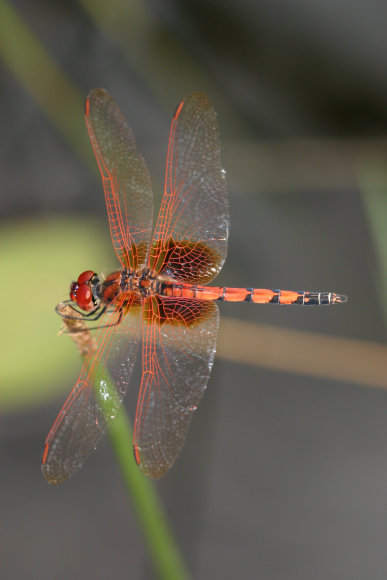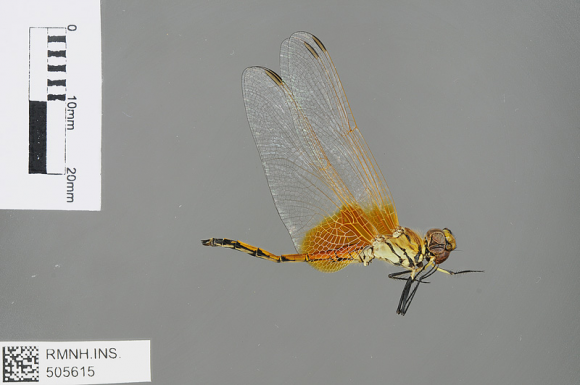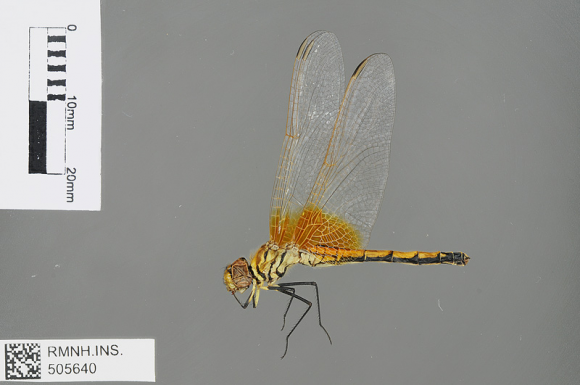Trithemis monardi Ris, 1931
Southern Fluttering Dropwing
Synonyms:
- scientific: ? Trithemis imitata Pinhey, 1961
- vernacular: Monard's D. (Su, RL)
Type locality: Chimporo, Angola
Diagnosis
Male is similar to T. imitata by (a) labrum at least partly pale; (b) black lines on thorax straight and slender, parallel and not merging; (c) Pt yellow to pale brown, contrasting with anterior and posterior black veins; (d) at least some basal veins yellow to red; (e) amber Hw patch includes triangle and anal loop, its distal border rather straight and perpendicular to costa, ending distal to tornus; (f) Abd slender, S4 over 3x as long as wide; (g) S8-9 largely black, with pale markings concentrated basally and/or dorsally; (h) lateral carinae of S5-7 usually marked with black; (i) S8 dorsal carina black at base, isolating pale basal spot. However, differs by (1) ranging from Zambia to Namibia and South Africa; (2) labium and labrum usually broadly black; (3) Hw base deep amber to brown, contrasting strongly with yellow veins with maturity; (4) venter of S7 broadly black at apex and narrowly black at base with broad pale band in-between, dorsum usually with corresponding gap in basal half of black lateral band. [Adapted from Dijkstra & Clausnitzer 2014; this diagnosis not yet verified by author]
Habitat description
Standing and probably often temporary waters, rivers and flowing channels in marshes in open landscapes. Usually with emergent vegetation. From 900 to 1700 m above sea level, but possibly down to sea level.
Distribution

Male © Jens Kipping
 Abdominal segment 2 (lateral view) |
Map citation: Clausnitzer, V., K.-D.B. Dijkstra, R. Koch, J.-P. Boudot, W.R.T. Darwall, J. Kipping, B. Samraoui, M.J. Samways, J.P. Simaika & F. Suhling, 2012. Focus on African Freshwaters: hotspots of dragonfly diversity and conservation concern. Frontiers in Ecology and the Environment 10: 129-134.
Barcode specimen(s):

Male; Democratic Republic of Congo, Katanga, © Dijkstra, K.-D.B.

Female; Democratic Republic of Congo, Katanga, © Dijkstra, K.-D.B.
References
- Ris, F. (1931). Odonata aus Süd-Angola. Revue Suisse Zoologie, 38, 97-112. [PDF file]
- Pinhey, E.C.G. (1961). Dragonflies (Odonata) of Central Africa. Occasional Papers Rhodes-Livingstone Museum, 14, 1-97. [PDF file]
- Pinhey, E.C.G. (1966). Check-list of dragonflies (Odonata) from Malawi, with description of a new Teinobasis Kirby. Arnoldia, 2, 1-24. [PDF file]
- Longfield, C. (1959). The Odonata of N. Angola. Part II. Publicacoes culturais Companhia Diamantes Angola, 45, 13-42. [PDF file]
- Lieftinck, M.A. (1969). Odonates Anisoptères - Odonata Anisoptera. Explor. hydrob. Lac Bangweolo and Luapula, 14, 1-64. [PDF file]
- Pinhey, E.C.G. (1970). Monographic study of the genus Trithemis Brauer (Odonata: Libellulidae). Memoirs Entomological Society Southern Africa, 11, 1-159. [PDF file]
- D' Andrea, M., and Carfi, S. (1997). Nuove raccolte di odonati del Camerun con note su Agriocnemis maclachlani Selys, 1877 edescrizione di Agriocnemis dissimilis sp. nov. e Trithemis osvaldae sp. nov. Atti Societa italiana Scienze naturali, 136, 157-190. [PDF file]
Citation: Dijkstra, K.-D.B (editor). African Dragonflies and Damselflies Online. http://addo.adu.org.za/ [2024-07-27].

